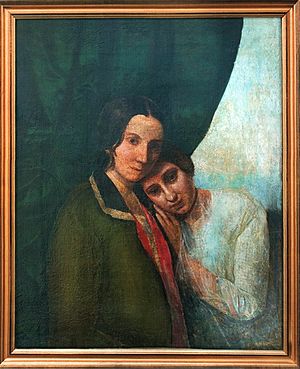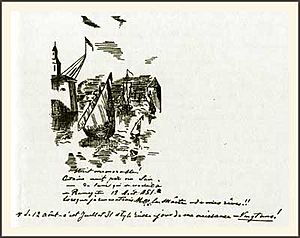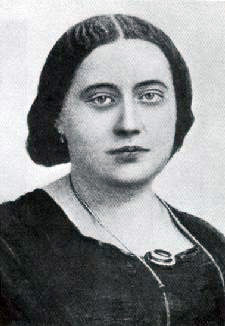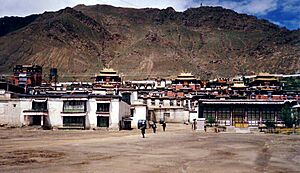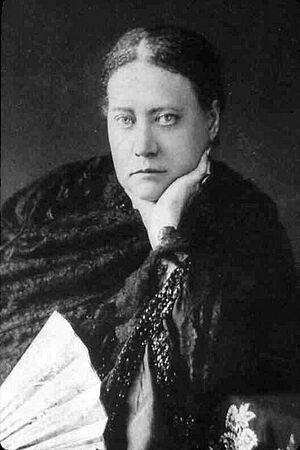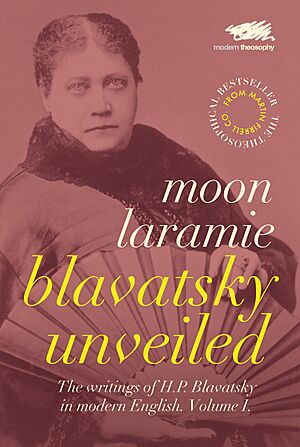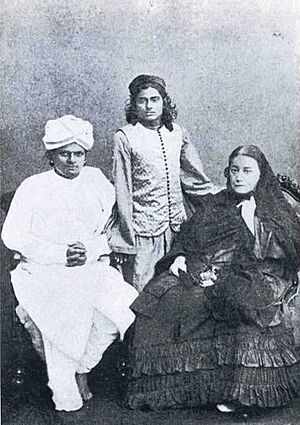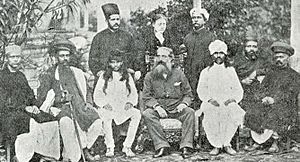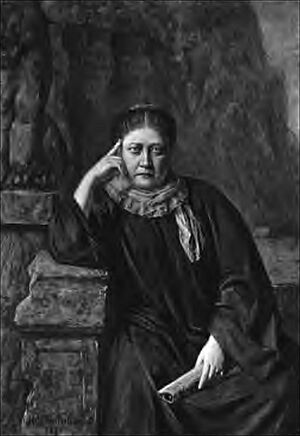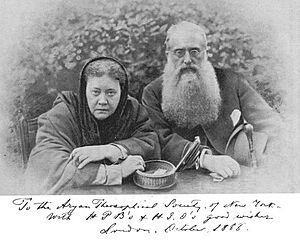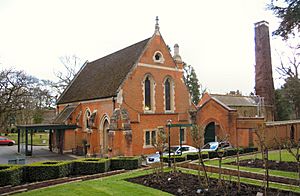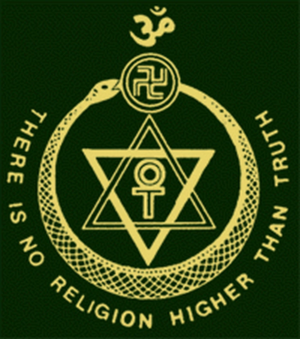Helena Blavatsky facts for kids
Quick facts for kids
Helena Blavatsky
|
|
|---|---|
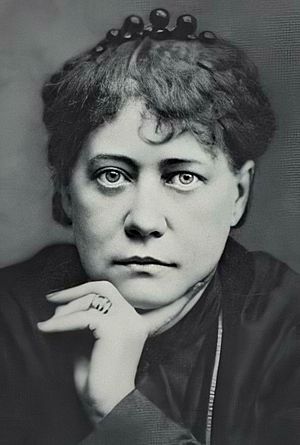
Blavatsky in 1877
|
|
| Born |
Yelena Petrovna von Hahn
12 August 1831 Yekaterinoslav, Russian Empire (now Dnipro, Ukraine)
|
| Died | 8 May 1891 City of London, London, England
|
|
Notable work
|
The Secret Doctrine (1888) |
| Era | Modern philosophy
|
| Region | Russian philosophy |
| School | Theosophy |
| Institutions | Theosophical Society |
|
Main interests
|
|
|
Notable ideas
|
|
|
Influences
|
|
|
Influenced
|
|
Helena Petrovna Blavatsky (born Hahn von Rottenstern; 12 August 1831 – 8 May 1891), often called Madame Blavatsky, was a Russian writer and mystic. She helped start the Theosophical Society in 1875. She became well-known around the world as the main thinker behind Theosophy.
Helena was born into a noble family in Yekaterinoslav, which was then part of the Russian Empire. This city is now called Dnipro in Ukraine. As a child, she traveled a lot within the empire. She taught herself many things and became interested in spiritual ideas during her teenage years. She later said that in 1849, she began traveling the world. She claimed to have visited Europe, the Americas, and India. She also said she met a group of wise spiritual teachers called the "Masters of the Ancient Wisdom". These Masters supposedly sent her to Shigatse, Tibet. There, they trained her to better understand how religion, philosophy, and science could be connected.
Some people at the time, and later writers, doubted if all her travels were real. They thought she might have spent this time in Europe. By the early 1870s, Blavatsky was involved in the Spiritualist movement. She believed that spiritual events were real. However, she disagreed with the common Spiritualist idea that the beings contacted were spirits of the dead. Instead, she thought they were other kinds of spiritual entities. In 1873, she moved to the United States. There, she became friends with Henry Steel Olcott and gained public attention as a spirit medium. Some people accused her of faking her abilities.
In 1875, in New York City, Blavatsky, Olcott, and William Quan Judge started the Theosophical Society. In 1877, she published Isis Unveiled, a book that explained her Theosophical ideas. She linked Theosophy to ancient spiritual teachings. Blavatsky described Theosophy as "the joining together of science, religion, and philosophy". She said it was bringing back an "Ancient Wisdom" that was the basis of all world religions. In 1880, she and Olcott moved to India. There, their Society worked with the Arya Samaj, a Hindu reform group. That same year, in Ceylon (now Sri Lanka), she and Olcott became the first Americans to officially become Buddhists.
The British rulers in India did not like Theosophy, but it grew quickly. However, the Society faced problems when Blavatsky was accused of faking some of her spiritual powers. Because of her poor health, she returned to Europe in 1885. She started the Blavatsky Lodge in London. There, she published The Secret Doctrine, which she said was based on old Tibetan writings. She also wrote two more books, The Key to Theosophy and The Voice of the Silence. She passed away from influenza in 1891.
Helena Blavatsky was a debated person during her life. Her supporters saw her as a wise teacher, while critics called her a trickster. Her Theosophical ideas helped spread Hindu and Buddhist thoughts in Western countries. They also influenced other spiritual movements like Ariosophy, Anthroposophy, and the New Age Movement.
Contents
Helena Blavatsky's Early Life
It is hard for people who write about Blavatsky's life to get a clear picture. This is because she sometimes gave different or untrue stories about her past. Also, very few of her own writings from before 1873 still exist. This means writers must rely on her later, less reliable, stories. Even accounts from her family members are sometimes questioned.
Childhood: 1831–1849
Birth and Family Background
Helena Blavatsky was born as Helena Petrovna Hahn von Rottenstern. This was in the town of Yekaterinoslav, in the Russian Empire. Her birthday was 12 August 1831. She was baptized into the Russian Orthodox Church right after she was born. At that time, a serious illness called cholera was spreading in Yekaterinoslav. Her mother got sick after Helena's birth, but both survived.
Blavatsky's family was from a noble background. Her mother, Helena Andreyevna Hahn von Rottenstern, was a smart 17-year-old. She was the daughter of Princess Yelena Pavlovna Dolgorukaya, who was also a well-educated noblewoman. Blavatsky's father, Pyotr Alexeyevich Hahn von Rottenstern, came from a German noble family. He was a captain in the Russian army and later became a colonel. Pyotr was not there when Helena was born. He was fighting in Poland. He first saw her when she was six months old. Blavatsky also had French ancestors. One of her great-great-grandfathers was a French nobleman who fled to Russia.
Because of her father's army job, the family moved often. They traveled to different parts of the Russian Empire with their servants. This moving around might have made Blavatsky enjoy traveling so much later in life. When Blavatsky was two, her younger brother, Sasha, died. In 1835, Helena and her mother moved to Odessa. Blavatsky's maternal grandfather, Andrei Fadeyev, worked there for the government. Her sister, Vera Petrovna, was born in Odessa.
Travels and Learning
After a short time back in Ukraine, her father was sent to Saint Petersburg. The family moved there in 1836. Blavatsky's mother liked the city and started writing novels. She also translated books from English writers. When her father returned to Ukraine around 1837, her mother stayed in Saint Petersburg. Later, Blavatsky and her mother went with her grandfather to Astrakhan. He was working with the Kalmyk people of Central Asia. The Kalmyks practiced Tibetan Buddhism. This was Blavatsky's first experience with this religion.
In 1838, Blavatsky's mother moved with her daughters to Poltava to be with her husband. There, she taught Blavatsky piano and dance. Because of her poor health, Blavatsky's mother went back to Odessa. In Odessa, Blavatsky learned English from a British teacher. The family then moved to Saratov, where her brother, Leonid, was born in June 1840. The family went to Poland and then back to Odessa. Blavatsky's mother died of tuberculosis in June 1842, at age 28.
The three children who were still alive went to live with their grandparents in Saratov. Their grandfather, Andrei, was the Governor there. Helena was described as a "spoiled, stubborn, sick child" who was a "charming storyteller". Her relatives said she mostly played with children from poorer families. She loved playing tricks and reading. She learned French, art, and music. These were subjects meant to help her find a husband. She also spent holidays with her grandparents at a Kalmyk summer camp. There, she learned to ride horses and some Tibetan.
She later said that in Saratov, she found her great-grandfather's personal library. It had many books on spiritual topics. This made her even more interested in these subjects. Her great-grandfather had been a Freemason. There were rumors that he had met famous mystics. She also claimed that around this time, she started having visions. In these visions, she saw a "Mysterious Indian" man. She said she would meet this man in real life later. Many writers believe this was the first time the "Masters" appeared in her life story.
She later claimed that in 1844–45, her father took her to England. She said she visited London and Bath. In London, she claimed to have taken piano lessons from a famous composer. However, some people who have studied Blavatsky's life think this trip to Britain never happened. Her sister's memoirs do not mention it. After living with her aunt for a year, she moved to Tiflis, Georgia. Her grandfather, Andrei, was working there. Blavatsky claimed she became friends with Alexander Vladimirovich Golitsyn, a Russian Freemason. He encouraged her interest in spiritual matters. She also said she had more strange experiences there. She claimed to have traveled outside her body and seen her "mysterious Indian" again in visions.
World Travels: 1849–1869
At 17, she agreed to marry Nikifor Vladimirovich Blavatsky. He was in his forties and worked as a Vice Governor. Her reasons for marrying him are not clear. She later said she was drawn to his belief in magic. She tried to back out just before the wedding, but it happened on 7 July 1849. She moved with him to the Sardar Palace. She tried many times to escape and return to her family in Tiflis. He finally let her go. Her family sent her with a servant and maid to Odessa to meet her father. He planned to take her back to Saint Petersburg. Her escorts went with her to Poti and then Kerch. Blavatsky claimed she ran away from her escorts. She said she bribed the ship captain and reached Constantinople. This was the start of nine years of traveling the world. Her father might have paid for these trips.
She did not keep a diary at the time. No relatives were with her to confirm her activities. So, what is known about these travels comes from "her own stories". These stories sometimes do not match up. One expert said there was "no reliable account" for the next 25 years of her life. Another said that at this point, "myth and reality begin to merge" in her life story.
She later claimed that in Constantinople, she became friends with a Hungarian opera singer named Agardi Metrovitch. She said she saved him from being murdered. In Constantinople, she also met Countess Sofia Kiselyova. She traveled with her to Egypt, Greece, and Eastern Europe. In Cairo, she met an American art student, Albert Rawson. They supposedly visited a Coptic magician together. In 1851, she went to Paris. There, she met a hypnotist, Victor Michal, who impressed her. From Paris, she visited England. She claimed that here she met the "mysterious Indian" from her childhood visions. He was a Hindu man she called Master Morya. She gave different stories about how they met. She said he told her he had a special mission for her. She had to travel to Tibet.
She traveled to Asia by way of the Americas. She went to Canada in late 1851. She hoped to meet Native American spiritual leaders. But she was robbed instead. She then traveled south, visiting New Orleans, Texas, Mexico, and the Andes mountains. From there, she sailed from the West Indies to Ceylon and then Bombay. She spent two years in India. She said she was following instructions in letters from Morya. She tried to enter Tibet, but the British rulers stopped her.
She later claimed she sailed back to Europe. She survived a shipwreck near the Cape of Good Hope. She arrived in England in 1854. There, she faced problems because she was Russian, and Britain was fighting Russia in the Crimean War. She claimed she worked as a musician there. She then sailed to the U.S. She visited New York City, Chicago, Salt Lake City, and San Francisco. Then she sailed back to India through Japan. In India, she spent time in Kashmir, Ladakh, and Burma. She then made a second attempt to enter Tibet. She claimed she succeeded this time. She said she entered Tibet in 1856 through Kashmir. She was with a Tartar shaman who wanted to reach Siberia. She said they reached Leh before getting lost. They joined a traveling Tartar group before she went back to India. She returned to Europe through Madras and Java.
After spending time in France and Germany, she returned to her family in Pskov in 1858. She later claimed that there, she started showing more spiritual abilities. She said that rapping and creaking sounds followed her. Furniture moved by itself. In 1860, she and her sister visited their grandmother in Tiflis. There, she met Metrovitch again. She also made peace with Nikifor in 1862. They adopted a child named Yuri. He died at age five in 1867.
In 1864, while riding in Mingrelia, Blavatsky fell from her horse. She was in a coma for several months with a broken spine. She recovered in Tiflis. She claimed that when she woke up, she had full control of her spiritual powers. She then went to Italy, Transylvania, and Serbia. She might have studied ancient Jewish mysticism there. In 1867, she went to the Balkans, Hungary, and then Italy. She spent time in Venice, Florence, and Mentana. She claimed that in Mentana, she was hurt fighting for Giuseppe Garibaldi at the Battle of Mentana.
Tibet
She claimed she then received a message from Morya to travel to Constantinople. There, he met her. Together, they traveled overland to Tibet. They went through Turkey, Persia, Afghanistan, and then into India. They entered Tibet through Kashmir. There, she said they stayed at the home of Morya's friend, Master Koot Hoomi. This home was near Tashilhunpo Monastery, Shigatse. Blavatsky said that both Morya and Koot Hoomi were from Kashmir. She claimed that Koot Hoomi taught students of Tibetan Buddhism at his home. Koot Hoomi was described as having spent time in London and Leipzig. He spoke English and French well. Like Morya, he was a vegetarian.
She claimed that in Tibet, she learned an old, unknown language called Senzar. She said she translated many ancient texts written in this language. These texts were kept by monks in a monastery. However, she said she was not allowed to enter the monastery itself. She also claimed that while in Tibet, Morya and Koot Hoomi helped her improve her psychic powers. She said these "Masters" could see things far away, hear things far away, read minds, control others' thoughts, make objects appear and disappear, and appear in two places at once. She claimed to have stayed on this spiritual retreat from late 1868 until late 1870. Blavatsky never wrote that she visited Lhasa. However, some later sources, including her sister's account, claimed she did.
Many critics and writers have doubted Blavatsky's claims about her visits to Tibet. Her stories are the only source, and there is no other proof. It was very hard for Europeans to enter Tibet in the 1800s. Visitors faced dangers from robbers and difficult land. This would have been even harder if Blavatsky was as heavy and not athletic as she was later in life. However, some writers have noted that traders and pilgrims from nearby lands could enter Tibet freely. This suggests she might have been allowed in if she was with Morya, especially if she was mistaken for an Asian person. Blavatsky's description of Shigatse was new to the Western world. One Buddhist scholar said she later showed a deep knowledge of Mahayana Buddhism. This knowledge was consistent with having studied in a Tibetan monastery. One writer said that if Blavatsky spent time in Tibet, she would be "one of the greatest travelers of the nineteenth century". But he added that he did not know if she really did. Another writer said that "hardly a word of this appears to be true" about her tales of Tibet and other adventures.
Helena Blavatsky's Later Life
Spiritualism and Theosophy: 1870–1878
Arriving in New York City
Blavatsky said she left Tibet with a goal. She wanted to show the world that the strange events seen by Spiritualists were real. She wanted to defend Spiritualism from claims of faking. However, she also said that the beings contacted by Spiritualist mediums were not spirits of the dead. She believed they were either playful spirits or the "shells" left behind by the dead. She traveled through the Suez Canal to Greece. There, she met another Master, Master Hilarion. She sailed for Egypt on a ship called the Eunomia. In July 1871, the ship exploded during the trip. Blavatsky was one of only 16 people who survived. She reached Cairo and met Metamon. With help from a woman named Emma Cutting, she started a spiritual group. This group was based on Spiritism, a type of Spiritualism that believed in reincarnation. This was different from the main Spiritualist movement. However, Blavatsky thought Cutting and many of the mediums were faking things. She closed the group after two weeks. In Cairo, she also met an expert on Egypt, Gaston Maspero, and another Master, Serapis Bey. She also met Metrovitch again, but he soon died of typhoid. Blavatsky said she oversaw his funeral.
Leaving Egypt, she went to Syria, Palestine, and Lebanon. There, she met people from the Druze religion. During these travels, she met the writer Lidia Pashkova. Pashkova later confirmed some of Blavatsky's travels during this time. In July 1872, Blavatsky returned to her family in Odessa. She left in April 1873. She spent time in Bucharest and Paris. She later claimed that Morya told her to go to the United States. Blavatsky arrived in New York City on 8 July 1873. She moved into a women's living cooperative in Manhattan. She earned money by sewing and designing ads. There, she got attention and was interviewed by a journalist from The Sun newspaper. This interview was the first time Blavatsky claimed to have spent time in Tibet. It was in New York that "detailed records" of Blavatsky's life become available to historians again. Soon after, Blavatsky learned her father had died. She inherited a lot of money, which allowed her to move into a fancy hotel.
Starting the Theosophical Society
Blavatsky was interested in a news story about William and Horatio Eddy. These brothers in Vermont claimed they could make things float and create spiritual events. She visited them in October 1874. There, she met the reporter Henry Steel Olcott. He was investigating the brothers' claims for a newspaper. Olcott said Blavatsky impressed him with her own ability to create spiritual events. He wrote a newspaper article about her. They soon became close friends. They gave each other nicknames: Olcott was "Maloney" and Blavatsky was "Jack". Olcott helped bring more attention to Blavatsky's claims. He encouraged his editor to publish an interview with her. He also wrote about her in his book on Spiritualism.
She began teaching Olcott her own spiritual beliefs. She encouraged him to live a simple life, without alcohol or meat. She herself found it hard to be a vegetarian. In January 1875, they visited some Spiritualist mediums in Philadelphia. The mediums asked Olcott to test them to prove their events were real. Olcott believed them. But Blavatsky thought they faked some things when real events did not happen.
To get people interested in their ideas, Blavatsky and Olcott published a letter. This was in a Spiritualist magazine in Boston. They called themselves the "Brotherhood of Luxor". They started living together in rented apartments in New York City. They decorated their homes with stuffed animals and pictures of spiritual figures. Olcott's work as a lawyer mostly paid for their life. Their last apartment was called the Lamasery. Blavatsky and Olcott started the Miracle Club. They said the Masters encouraged them to do this. Through this club, they held talks on spiritual topics in New York City. Here, they met an Irish Spiritualist, William Quan Judge, who shared their interests.
At a Miracle Club meeting on 7 September 1875, Blavatsky, Olcott, and Judge decided to start a spiritual group. Someone suggested they call it the Theosophical Society. The word theosophy comes from Greek words meaning "god-wisdom" or "divine wisdom". This word was not new. It had been used before by other mystics. Theosophists often argued about how to define Theosophy. Judge thought it was impossible. But Blavatsky said Theosophy was not a religion itself. One writer described the movement as "a very wide umbrella, under which quite a few things could find a place".
When the Society started, Olcott was the chairman. Judge was the secretary. Blavatsky was the corresponding secretary. But she was the main thinker and leader of the group. Important early members included Emma Hardinge Britten and Thomas Edison. Many were successful people, but not all stayed members for long.
Isis Unveiled
The main idea in these different topics [in Isis Unveiled] is that an ancient wisdom-religion exists. This is a timeless, hidden guide to the universe, nature, and human life. The many faiths of humans are said to come from a universal religion known to both Plato and the wise Hindu teachers of old. This wisdom-religion is also linked to Hermetic philosophy as "the only possible key to the Absolute in science and theology." Every religion is based on the same truth, or "secret doctrine," which holds "the beginning and end of universal science." This ancient wisdom-religion will become the religion of the future.
In 1875, Blavatsky started writing a book to explain her Theosophical ideas. Much of it was written while she stayed at the home of a professor at Cornell University. She wanted to call it The Veil of Isis, but it was published as Isis Unveiled. While writing, Blavatsky claimed she felt a second mind inside her. She called it "the lodger who is in me". She said this second mind inspired much of her writing. In Isis Unveiled, Blavatsky quoted many other spiritual and religious texts. Her friend Olcott always said she quoted from books she did not have. One writer later thought that if this was true, she must have had a perfect memory. He said that even if she used other sources, the book put together ideas in a new way.
The book was about Blavatsky's idea that all religions came from one "Ancient Wisdom". She linked this to old spiritual traditions of the West. It also shared her thoughts on Spiritualism. It criticized Darwinian evolution, saying it only looked at the physical world, not the spiritual.
A philosophy professor edited the book. It was published in two parts in 1877. Mainstream newspapers gave it bad reviews. They pointed out that it quoted about 100 other books without saying where they came from. But it sold very well. The first 1,000 copies sold out in a week. The publisher asked for a second book, but Blavatsky said no. Even though Isis Unveiled was a success, the Society was not very active in late 1876. This was true even though new groups had started in the U.S. and London. Famous people like Thomas Edison had joined. In July 1878, Blavatsky became a U.S. citizen.
India: 1879–1885
The Theosophical Society connected with an Indian Hindu reform movement called the Arya Samaj. Blavatsky and Olcott believed the two groups shared similar spiritual views. Blavatsky was not happy in the U.S., so she decided to move to India. Olcott agreed to join her. He got a job as a U.S. trade representative there. In December, they sold many of their things. Edison gave them a phonograph to take to India. They left New York City on a ship. It took them to London. After meeting supporters there, they traveled to Liverpool. They sailed from there and arrived in Bombay in February 1879. In the city, members of Arya Samaj welcomed them with celebrations. They then got a house in Bombay's local area.
Blavatsky mostly spent time with Indians, not the British rulers. She hired a 15-year-old boy from Gujarat, Vallah "Babula" Bulla, as her personal helper. Many educated Indians were impressed that Theosophists supported Indian religions. This happened when India was trying to assert itself against the British Empire's ways. British spies watched her activities. They thought she might be working for Russia. In April, Blavatsky took Olcott, Babula, and their friend Moolji Thackersey to the Karla Caves. She said the caves had secret passages that led to an underground place where the Masters met. Then she claimed the Masters were telling her by mind to go to Rajputana in the Punjab. So she and Olcott went north. At the Yamuna river, they met a holy man who had sat in a special yoga pose for 52 years. In Agra, they saw the Taj Mahal. In Saharanpur, they met Dayananda and his Arya Samaj followers. Then they returned to Bombay.
In July 1879, Blavatsky and Olcott started a monthly magazine called The Theosophist. The first issue came out in October. The magazine soon had many readers. Damodar K. Mavalankar, a Theosophist, took over managing it. He started the idea of calling the Masters mahatmas. In December, Blavatsky and Olcott traveled to Allahabad. They visited Alfred Percy Sinnett, the editor of a newspaper and a keen Spiritualist. A.O. Hume was also a guest at Sinnett's home. Blavatsky was encouraged to show spiritual events in front of them. From there, they went to Benares. They stayed at the palace of a local ruler. Blavatsky and Olcott were then invited to Ceylon by Buddhist monks. There, they officially became Buddhists. They were the first Americans to do so. They took the Five Precepts in a ceremony in May 1880. They toured the island. Crowds were curious about these unusual Westerners who embraced Buddhism instead of trying to convert people to Christianity. Their message helped Sinhalese people feel proud of their culture. They were invited to see the Buddha's Tooth in Kandy.
Blavatsky learned that an old friend, Emma Coulomb, and her husband were poor in Ceylon. Blavatsky invited them to live in her home in Bombay. However, the Coulombs annoyed two American Theosophists who were also living with Blavatsky. When Blavatsky sided with the Coulombs, the Americans went back to the U.S. Blavatsky was then invited to Simla to spend more time with Sinnett. There, she performed many spiritual events that amazed the other guests. Once, she supposedly made a cup and saucer appear under the soil during a picnic. Sinnett wanted to contact the Masters himself. He convinced Blavatsky to help him. This led to over 1400 pages supposedly written by Koot Hoomi and Morya. These became known as the Mahatma Letters. Sinnett summarized the teachings in these letters in his book Esoteric Buddhism (1883). However, Buddhist scholars like Max Müller publicly said the book's ideas were not Buddhist. Blavatsky herself did not like the misleading title. Since the book was published, there has been much debate about if the letters were real. Some say Blavatsky wrote them herself. Others believe different people wrote them. One writer said, "there can be no reasonable doubt that Helena was their author".
Theosophy was not liked by Christian missionaries or the British rulers. India's English newspapers were mostly negative about the Society. But the group was still popular. Branches started all over the country. Blavatsky had focused on growing the group among native Indians, not just the British elite. But she moved into a comfortable house in a rich Bombay area. She said it was easier for Western visitors to reach. Olcott decided to start a fund to help Buddhist education. This was to fight the spread of Christianity in Ceylon. It also aimed to encourage pride in Buddhism among the island's people. Blavatsky first opposed the idea. She said the Masters would not approve. But Olcott's project was a success, and she changed her mind.
Blavatsky was diagnosed with a kidney disease. Hoping the weather would be better for her, she accepted an offer from the Society's Madras Branch to move to their city. However, in November 1882, the Society bought a property in Adyar. This became their main headquarters. A few rooms were set aside for Blavatsky, and she moved in in December. She continued to travel around India. She claimed she then spent time in Sikkim and Tibet. She said she visited her teacher's spiritual home for several days. As her health got worse, she agreed to go with Olcott on his trip to Britain. He planned to speak for Ceylonese Buddhism and fix problems with the Society's London group.
She sailed to Marseilles, France, in March 1883. She spent time in Nice with the founder of the French Theosophical Society. She then continued to Paris. In London, she attended a meeting of the group. She tried to stop arguments between different members. Not happy, one member left the Theosophical Society to form another group. In London, Blavatsky contacted the Society for Psychical Research (SPR). She agreed to let them study her and her claimed spiritual abilities. But she was not impressed by the group. She jokingly called it the "Spookical Research Society".
While Blavatsky was in Europe, problems started at the Society's Adyar headquarters. This became known as the Coulomb Affair. The Society's leaders accused Emma Coulomb of taking their money for herself. They asked her to leave their center. She and her husband refused. They tried to get money from the Society. They claimed they had letters written by Blavatsky that proved her spiritual abilities were fake. The Society refused to pay them. They forced the couple to leave. The couple then went to a magazine in Madras. The magazine published a story saying Blavatsky was faking things, based on the Coulombs' claims. The story got international attention. A London newspaper also picked it up. In response, in November 1884, Blavatsky went to Cairo. There, she and a Theosophist searched for negative information about Emma Coulomb. They found stories about her past claims of trying to get money from people and other bad acts. Inside the Society, the Coulomb Affair caused a lot of damage. But it remained popular in India, as did Blavatsky herself.
Final Years in Europe: 1885–1891
Blavatsky's health got worse. She thought about returning to the milder climate of Europe. She resigned from her job as corresponding secretary of the Society. She left India in March 1885. By 1885, the Theosophical Society had grown very fast. It had 121 groups around the world. 106 of these were in India, Burma, and Ceylon. At first, each group was directly started by the Adyar headquarters. Members made decisions by voting. But over the next few years, the groups were organized into national units with their own leaders. This caused some disagreements between the different levels of management.
She settled in Naples, Italy, in April 1885. She lived on a small pension from the Society. She continued working on her next book, The Secret Doctrine. She then moved to Würzburg in Germany. There, a Swedish Theosophist, Countess Constance Wachtmeister, visited her. The Countess became her constant companion for the rest of her life. In December 1885, the SPR published their report on Blavatsky and her claimed spiritual events. The report was written by Richard Hodgson. In his report, Hodgson accused Blavatsky of being a spy for the Russian government. He also accused her of faking spiritual events. This was mostly based on the Coulombs' claims. The report caused a lot of tension within the Society. Some of Blavatsky's followers left the group because of it.
Blavatsky wanted to sue those who accused her. But Olcott advised against it. He believed the public attention would harm the Society. In private letters, Blavatsky said she was relieved that the criticism was focused on her. She was glad that the Masters' identities had not been publicly revealed. For many years after, Theosophists criticized Hodgson's method. They said he tried to prove Blavatsky wrong instead of studying her claims fairly. In 1986, the SPR admitted this was true and took back the report's findings. However, one writer said that Theosophists have seen this as a complete victory. But he added that many questions raised by Hodgson still have no answers.
In 1886, Blavatsky was using a wheelchair. She moved to Ostend in Belgium. Theosophists from all over Europe visited her there. Among them was a doctor who treated her during a very serious illness in March 1887. Blavatsky said he saved her life. To add to her pension, she started a small business making ink. She received messages from members of the Society's London group. They were unhappy with how their leader was running it. They thought he was focusing on getting support from rich people. They felt he was not promoting Theosophy to everyone. Blavatsky agreed with this criticism. She arrived in London in May 1887. She first stayed at the home of a Theosophist. In September, she moved into the home of fellow Theosophists, Bertram and Archibald Keightley.
In London, she started the Blavatsky Lodge. This group competed with the one run by Sinnett. It took many of its members. Lodge meetings were held at the Keightleys' house on Thursday nights. Blavatsky also met many visitors there, including the writer W. B. Yeats. In November 1889, the Indian lawyer Mohandas Gandhi visited her. He was studying a Hindu holy book with the Keightleys. He became a member of Blavatsky's Lodge in March 1891. He would later stress the strong connection between Theosophy and Hinduism throughout his life. In 1888, Blavatsky created the Esoteric Section of the Theosophical Society. This group was completely under her control. Only those who passed certain tests could join. She said it was a place for "true Theosophists". They would focus on the system's philosophy, not on trying to create spiritual events.
Publishing
In London, Blavatsky started a magazine. She controversially named it Lucifer. In this Theosophical publication, she aimed to ignore claims about spiritual events. Instead, she wanted to focus on discussing philosophical ideas. Blavatsky also finished writing The Secret Doctrine. The Keightleys edited it. No commercial publisher wanted to publish the roughly 1,500-page book. So, Blavatsky started the Theosophical Publishing Company. They published the work in two volumes. The first came out in October 1888, and the second in January 1889. Blavatsky claimed the book was her explanation of the Book of Dzyan. This was a religious text written in Senzar. She said she learned it while studying in Tibet. One scholar claimed he found Books of Kiu-te, including Blavatsky's Book of Dzyan, as a first volume. He said it was part of the Tibetan Buddhist canon. However, most Buddhist scholars who have looked at The Secret Doctrine have concluded there was no such text as the Book of Dzyan. They believe it was Blavatsky's own made-up creation. In the book, Blavatsky explained her ideas about how the universe, planets, and humans came to be. She also discussed her views on humans and their souls, including what happens after death.
Annie Besant
The social reformer Annie Besant reviewed the two-volume book for a newspaper. She was impressed by it. Besant met Blavatsky and joined the Theosophists. In August 1890, Blavatsky moved into Besant's large house in London.
She made Besant the new head of the Blavatsky Lodge. In July 1890, she opened the new European headquarters of the Theosophical Society in Besant's house. There, she wrote a book with questions and answers, The Key to Theosophy. This was followed by The Voice of the Silence. This was a short spiritual text. She claimed it was based on a Senzar text called The Book of the Golden Precepts. Like The Secret Doctrine, most Buddhist scholars have doubted that this text was a real Tibetan Buddhist document. She continued to face accusations of faking things. A U.S. newspaper published an article in July 1890. It was based on information from a former member of the Society. Blavatsky sued the newspaper for lying. They publicly took back their accusations in September 1892.
Death
That winter, Britain had a flu sickness spreading (the worldwide 1889–1890 flu pandemic). Blavatsky caught the virus. It led to her death on the afternoon of 8 May 1891, in Besant's house. Theosophists have remembered this date ever since as White Lotus Day. Her body was cremated at Woking Crematorium on 11 May.
Personal Life
One writer described Blavatsky as "a short, stout, strong woman". She had "several chins, messy hair, a determined mouth, and large, slightly bulging eyes". She had unique blue eyes and was overweight throughout her life. According to another writer, Blavatsky's "overall look was very messy". Later in life, she was known for wearing loose robes and many rings on her fingers. She lived simply. Her followers believed she refused money for sharing her teachings. Blavatsky preferred to be called "HPB". This nickname was given to her by many friends. She avoided social events and did not care much for social rules. She spoke Russian, Georgian, English, French, Italian, Arabic, and Sanskrit.
One writer called her "an unusual person who followed no rules but her own". She had "complete disregard for the Victorian code of morality". This writer believed Blavatsky saw herself as a special leader. Her purpose was to save the world by promoting Theosophy. Another writer said Blavatsky showed "Russian traits". These included a strong dedication to spiritual truth, mixed with a very different personality. He also said she had a "vivid imagination" and a "tendency to lie". Someone else noted that Blavatsky had "a fearsome temper". A scholar said she was a "strong-willed, independent child". He thought the tough times in her childhood might have made it hard for her to control her temper and use bad words. In his opinion, she was a "natural leader" who inspired many people.
One expert said Blavatsky's energy was surprising. Another said her charm influenced many people.
Blavatsky was married to two men during her life. However, some have suggested she might have been a lesbian.
Social and Political Ideas
One writer suggested that Blavatsky's life work was "not only spiritual but socially idealistic and fiercely political". He said her "emotional fuel" was partly "a hatred of oppression". This was either from the strong control of Christianity or British rule in India. On the other hand, another writer thought Blavatsky was "basically a non-political person".
Blavatsky's social and political ideas were not always the same. This was like many other things in her life. But they showed what she felt she could share about a bigger vision. This vision was mostly about the idea of different "root races" of humanity. These races were a mix of culture and physical traits. Races often combined over time. Also, these races were seen as changing and developing. One writer noted that in Isis Unveiled (1877), Blavatsky gave the first major intellectual criticism of evolution. Blavatsky believed that Darwin's theory explained how humans physically evolved. But she thought spirituality followed a different path of development.
A scholar of religion noted that "sometimes" Blavatsky's writings were "openly racist". He added that her dislike of Jewish people came from the fact that Judaism was the origin of Christianity. He said it was because of "the intense dislike she felt for Christianity". She wrote that "Judaism ... has become one of the latest creeds in Asia, and theologically a religion of hate and malice toward everyone and everything outside themselves."
However, she also used the Jewish mystical system, the Kabbalah, a lot and in a positive way. She thought its origins were older than historical Judaism. Henry Steel Olcott, in his writings, told of a "mystical Hebrew physician". This physician had studied the Kabbalah deeply for thirty years. He discussed it with Blavatsky in long talks. He reportedly said that despite his deep research, "he had not discovered the true meanings that she read into certain texts, and that illumined them with a holy light." In a part of Isis Unveiled, Blavatsky praised Jewish people. She wrote: "Nor should we compel the Jews to do penance for their fathers... How faithfully and nobly they have stood by their ancestral faith under the diabolical persecutions... The Jews remain substantially united. Even their differences of opinion do not destroy their unity."
As for Christianity, she mostly disliked Roman Catholicism and missionary Protestantism. She had good relationships with some liberal Protestants. She also did not criticize her own Russian Orthodox Church much. In Isis Unveiled, she spoke well of Jesus. She said he was a "poor, unknown Jewish carpenter" who became a great reformer. He taught a "sublime code of ethics". She also said he was an "initiate", able to teach and practice the Ancient Wisdom in ways suitable for his time and place. She also used Gnosticism in a positive way. Gnosticism is now seen as a valid early form of Christianity.
About physical races, she wrote that Africans, Aboriginal Australians, and South Sea Islanders were not as advanced as Europeans. She wrote that "souls of the lowest types of humans (the 'narrow-brained' savage South-Sea Islander, the African, the Australian) had no past actions to work out when first born as men, as their more favored brothers in intelligence had." She called aboriginal Australians "half-animal". However, the changing, evolving nature of races must also be remembered. In The Secret Doctrine, she suggested that if Europe disappeared and other lands appeared, and if African tribes spread out, they would form the main part of civilized nations in about a hundred thousand years. So, she said, the reason for dividing humanity into "superior" and "inferior" races becomes false. In 1886, two years before The Secret Doctrine and five years before Blavatsky's death, the Theosophical Society made its first goal: "To form the beginning of a Universal Brotherhood of Humanity without distinction of race, creed, or color." In 1888, "without distinction of sex or caste" was added.
Theosophy: Ideas and Teachings
According to one writer, Blavatsky put her ideas and teachings together bit by bit. Blavatsky claimed that these Theosophical teachings were not her own. She said she received them from a group of secret spiritual teachers. She called them the "Masters" or "Mahatmas".
Theosophy, the Masters, and "Ancient Wisdom"
Blavatsky was the main thinker of the Theosophical Society. She was responsible for setting up its "main ideas". The ideas in her published books form the basis from which the Society and the larger Theosophical movement grew. Blavatsky's Theosophical ideas were a type of occultism. She believed in an ancient and universal "hidden science" that should be brought back. Blavatsky said that the Theosophical teachings were given to her by wise teachers. These teachers lived in different parts of the world.
The main idea behind Blavatsky's Theosophy was that there was an "ancient wisdom religion". This religion was once found all over the world. Many ancient figures, like the Greek philosopher Plato and old Hindu sages, knew about it. Blavatsky connected this ancient wisdom religion to Hermetic philosophy. This view believes that everything in the universe comes from a single God. Blavatsky thought that all the world's religions grew from this original global faith. Blavatsky saw her Theosophy as following the Neoplatonist philosophers of ancient times. They also believed in Hermetic philosophy. Blavatsky claimed that because Christianity spread in Europe, this magical tradition was lost there. But she said it continued in a changed form in India and Africa. Blavatsky believed that the Theosophical movement's bringing back of the "ancient wisdom religion" would make it spread worldwide. It would then become more important than the established world religions. So, by bringing these Theosophical ideas to humanity, Blavatsky saw herself as a special, guiding figure.
According to one expert, the Theosophical Society "spread a detailed philosophical system". This system included how the universe began, the universe's large scale, spiritual levels, and beings in between. These beings matched a similar idea of humans on a small scale. Officially, the Society had three main goals:
- To form a group of people who believe in a Universal Brotherhood of Humanity. This means people should be treated equally, no matter their race, religion, gender, social class, or skin color.
- To encourage the study of different religions, philosophies, and sciences.
- To explore the unexplained laws of Nature and the hidden powers within humans.
One writer believed that these three goals would lead to "discovering the hidden powers in humans". This would happen through studying science, philosophy, and religion in a spiritual way. This would then lead to social peace and equality.
While living in New York City, Blavatsky called herself a "Buddhist". But she officially became a Buddhist only when she was in Ceylon. However, one writer said her Buddhism was "very unusual" and "had little to do with the Buddhism of scholars... or that of your average Buddhist". Blavatsky argued that The Buddha wanted to return to the teachings of the Vedas. She believed Buddhism was a more accurate survival of ancient Brahmanism than modern Hinduism. Although she criticized Catholicism and Protestantism, and did not like their growth in Asia, she always felt very positively about the Russian Orthodox Church. She said that "with the faith of the Russian Church I will not even compare Buddhism".
A Theosophist named G. R. S. Mead said, "Two things in all the chaos of her [Blavatsky's] world remained firm in every mood – that her Teachers existed and that she had not cheated."
God, the Universe, and Humanity
Blavatsky explained what has been called a "single-God, everywhere-present, and mystical view of the universe". Blavatsky was a pantheist. This means she believed God was in everything. She stressed the idea of a God that was not a person. She called the Theosophical God a "universal Divine Principle". This was the source of everything. Everything comes from it, and everything will return to it at the end of the great cycle of existence. She did not like the Christian idea of God in the Western world. She called it "a bundle of contradictions and a logical impossibility." She said the universe came from this Divine Principle. Every tiny bit of matter had a spark of the divine in it. Lower forms of existence came from higher ones. Then they became more solid and were absorbed back into the Divine Principle. This idea of the universe was similar to the scientific discoveries of geology and how living things evolved. Both of these were found by science in the 1800s.
In The Secret Doctrine, Blavatsky explained that at the beginning of time, there was nothing. This first essence then split into seven Rays. These Rays were also intelligent beings called the Dhyan Chohans. These Seven Rays then created the universe using an energy called Fohat. The Earth was created and went through seven "Rounds". In each Round, different living beings were created.
Blavatsky taught the idea of "Root Races". Each Root Race was divided into seven smaller "Sub-Races". In Blavatsky's view of how the universe began, the first Root Race was made of pure spirit. They lived on a land called the "Imperishable Sacred Land". The second Root Race, called the Hyperboreans, were also made of pure spirit. They lived on a land near the North Pole, which then had a mild climate. The third lived on the continent of Lemuria. Blavatsky said parts of it still exist today as Australia and Rapa Nui. Blavatsky claimed that during the fourth Round of the Earth, higher beings came down to the planet. Human physical bodies started to develop, and the sexes separated. At this point, the fourth Root Race appeared. They lived on the continent of Atlantis. They had physical bodies but also psychic powers and advanced technology. She claimed some Atlanteans were giants and built ancient structures like Stonehenge in England. She also said they had children with "she-animals". This resulted in the creation of gorillas and chimpanzees. The Atlanteans became corrupt and misused their power and knowledge. So Atlantis sank into the sea. However, some Atlanteans escaped and created new societies in Egypt and the Americas.
The fifth Root Race to appear was the Aryans. They were found all over the world at the time she was writing. She believed that the fifth Race would be replaced by the sixth. This would be announced by the arrival of Maitreya, a figure from Buddhist stories. She also believed that humanity would eventually develop into the final, seventh Root Race. One writer suggested that if we read Blavatsky's ideas about how the universe began as a literal history, "we may be doing it a disservice." He instead suggested it could be read as Blavatsky trying to create "a new myth for the modern age, or as a huge, fantastic science fiction story".
Blavatsky taught that humans are made of three separate parts: a divine spark, an astral fluid body, and the physical body. Later, Blavatsky said that humans and the Universe had seven parts. According to Blavatsky, humans are made of seven parts: Atma, Buddhi, Manas, Kama rupa, Linga sharira, Prana, and Sthula sharira. In Isis Unveiled, Blavatsky said that humans would not be reincarnated back on Earth after physical death. However, by the time she wrote The Secret Doctrine, she had changed her mind. This was likely because of her time in India. Here, she said that the law of reincarnation was controlled by karma. Humanity's final goal was for the soul to be free from the cycle of death and rebirth. She believed that knowing about karma would make sure humans lived by good rules. She argued that it gave a much better reason for good actions than Christian teachings. Blavatsky wrote, in Isis Unveiled, that Spiritualism "alone offers a possible last refuge of compromise between" the "revealed religions and materialistic philosophies". While she admitted that very strong believers "remained blind to its imperfections", she wrote that such a fact was "no excuse to doubt its reality". She said that Spiritualist fanaticism was "itself a proof of the genuineness and possibility of their phenomena".
One expert noted that Blavatsky's ideas about the universe had four main features of Western spiritual traditions:
- Connections between all parts of the universe, like the big universe and the small human.
- Living nature as a complex, many-sided, layered, and alive whole.
- Imagination and spiritual helpers, symbols, and special diagrams.
- The experience of changing the soul through cleaning and rising up.
Influence
Theosophical Movement
According to one expert, the Theosophical movement of the 1800s was mainly created and shaped by H.P. Blavatsky's smart ideas. He said that "without her strong leadership and firm promotion of the Theosophical plan, it seems unlikely that the movement could have reached its unique form." By the time she died in 1891, she was the recognized leader of a group of nearly 100,000 people. They had magazines in London, Paris, New York, and Madras. Her writings have been translated and published in many European and Asian languages.
Blavatsky's Theosophy changed interest in Spiritualism. It moved it towards a more clear teaching that included ideas about the universe and evolution. This helped people understand humanity's spiritual development. Also, it took traditional Western spiritual ideas and made them global. It did this by restating many of their ideas using words from Asian religions. Blavatsky's Theosophy was able to appeal to women. It made gender less important and allowed women to take on spiritual leadership equal to men. This gave them a bigger role than what was allowed in traditional Christianity.
Since it started, Theosophy has also led to or influenced other mystical, philosophical, and religious movements. In the 1920s, the Theosophical Society Adyar had about 7,000 members in the U.S. There were also many followers in Asia. According to a Theosophical source, the Indian section in 2008 had about 13,000 members. In the U.S., the 2008 membership was about 3,900.
Western Spiritual Ideas
Blavatsky's Theosophy has been called "a major factor in the modern revival" of Western spiritual traditions. One expert said there was "no more important figure in modern times" in Western spiritual traditions than Blavatsky. Another said Blavatsky was "a central figure in the nineteenth-century occult revival". One writer claimed that "practically all modern occultism and esotericism" can be traced back to her influence. Blavatsky's published Theosophical ideas, especially those about Root Races, have been mentioned as an influence on Ariosophy. This was a spiritual movement started in Germany and Austria in the late 1800s and early 1900s. One writer said that through Ariosophy, Blavatsky's Theosophical ideas "contributed to Nazi ideology". However, another writer said that Blavatsky should not be blamed for any of the anti-Jewish and racist ideas that the Ariosophists promoted. He said that if she were alive to see Ariosophy develop, she probably would have spoken out against its ideas about race. Blavatsky's Theosophical ideas about Root Races have also been mentioned as an influence on Anthroposophy. This was a spiritual movement developed by Rudolf Steiner in Germany in the early 1900s. Steiner's group is called a "historical offshoot" of the Theosophical Society.
Blavatsky's Theosophy has been mentioned as an influence on the New Age Movement. This was a spiritual trend that appeared in Western countries in the 1970s. "No single organization or movement has given so many parts to the New Age Movement as the Theosophical Society. ... It has been the main force in spreading spiritual books in the West in the twentieth century." Other groups loosely based on Theosophical texts and ideas include the Agni Yoga. Also, a group of religions based on Theosophy called the Ascended Master Teachings: the "I AM" Activity, The Bridge to Freedom, Universal Medicine and The Summit Lighthouse, which became the Church Universal and Triumphant.
Linguistics
An American scholar of religion, Jason Josephson-Storm, has argued that Blavatsky and her Theosophical Society influenced academic linguistics in the late 1800s and early 1900s. Josephson-Storm notes that Blavatsky's ideas about language were widely known in Europe. He also points out that important linguists either practiced Theosophy or publicly defended its ideas. Ferdinand de Saussure is also known to have attended spiritual meetings. He wrote a long analysis of Theosophical claims about language and India.
South Asian Religion and Politics
One writer suggested that Blavatsky had a greater impact in Asia than in the Western world. Blavatsky has been said to have inspired Hindus to respect their own religious roots. The Theosophical Society influenced the growth of Indian national pride. Important figures in the Indian independence movement, like Mohandas Gandhi and Jawaharlal Nehru, were inspired by Theosophy to study their own country's heritage. The Theosophical Society had a big influence on Buddhist modernism and Hindu reform movements. Blavatsky and Olcott took part in a movement to revive Theravada Buddhism in Ceylon.
One writer stated that "more than any other single individual", Blavatsky was responsible for bringing knowledge of Eastern religion and philosophy to the West. Blavatsky believed that Indian religion offered answers to problems Westerners faced. In particular, she believed that Indian religion had ideas about how the universe evolved. These ideas matched Darwin's theory of evolution. She also thought that the Indian idea of reincarnation answered many moral concerns about punishment and eternal suffering that worried Westerners in the 1800s. By doing this, the writer believed Blavatsky prepared the way for later movements. These included groups like the International Society for Krishna Consciousness, Transcendental Meditation movement, Zen Buddhism, and yoga in the West. Another writer believed that the two greatest achievements of Blavatsky's movement were making belief in reincarnation popular. Also, making popular the idea of a single divine world soul in the West.
Blavatsky "both included many ideas from Eastern religions into her spiritual beliefs, and explained Eastern religions using her spiritual beliefs". By doing this, she spread a view of the "mystical East" that was already popular through Romantic poetry. Max Müller strongly criticized Blavatsky's Esoteric Buddhism. While he gave her credit for good intentions at the start of her work, he felt she stopped being truthful with her later "hysterical writings and performances". He wrote that there is nothing hidden or secret in Buddhism. In fact, it is the opposite. "Whatever was secret was not Buddha's teaching; whatever was Buddha's teaching was not secret". Blavatsky, it seemed to Müller, "was either tricked by others or carried away by her own imagination." Blavatsky replied to the academic experts in Indian religion who said she was misrepresenting it. She claimed they only understood the outer part of Hinduism and Buddhism. They did not understand the inner, secret parts of these faiths, which she traced back to the ancient Vedas.
Books by Helena Blavatsky
- Isis Unveiled: A Master-Key to the Mysteries of Ancient and Modern Science and Theology (1877)
- Studies in Occultism: A collection of articles from Lucifer (1887–1891)
- From the Caves and Jungles of Hindostan (1879–1886)
- The Secret Doctrine: The Synthesis of Science, Religion and Philosophy (1888)
- The Voice of the Silence (1889)
- The Key to Theosophy (1889)
- Nightmare Tales (1907)
- The Land of the Gods (2022)
Images for kids
See also
 In Spanish: Helena Blavatsky para niños
In Spanish: Helena Blavatsky para niños
- Charles Webster Leadbeater
- Annie Besant
- Alice Bailey
- Benjamin Creme
- Helena Roerich
- Edward Bulwer-Lytton
- Schola Philosophicae Initiationis
- Alexander Scriabin
- Rudolf Steiner
- Martinus
- Theosophical mysticism
- Theosophy and Buddhism
- Theosophy and Christianity
- Theosophy and Hinduism
- Theosophy and literature
- Theosophy and visual arts
- Theosophy and Western philosophy
- Tulpa
- Violet Tweedale, close associate of Blavatsky
- "What Is Theosophy?" – article by Blavatsky



